- AI Fire
- Posts
- 💸 This AI Search Box Is An Untapped Online Income Stream
💸 This AI Search Box Is An Untapped Online Income Stream
Learn how this AI's unique abilities can find profitable niches, construct fact-based affiliate articles, and generate traffic for a reliable income.
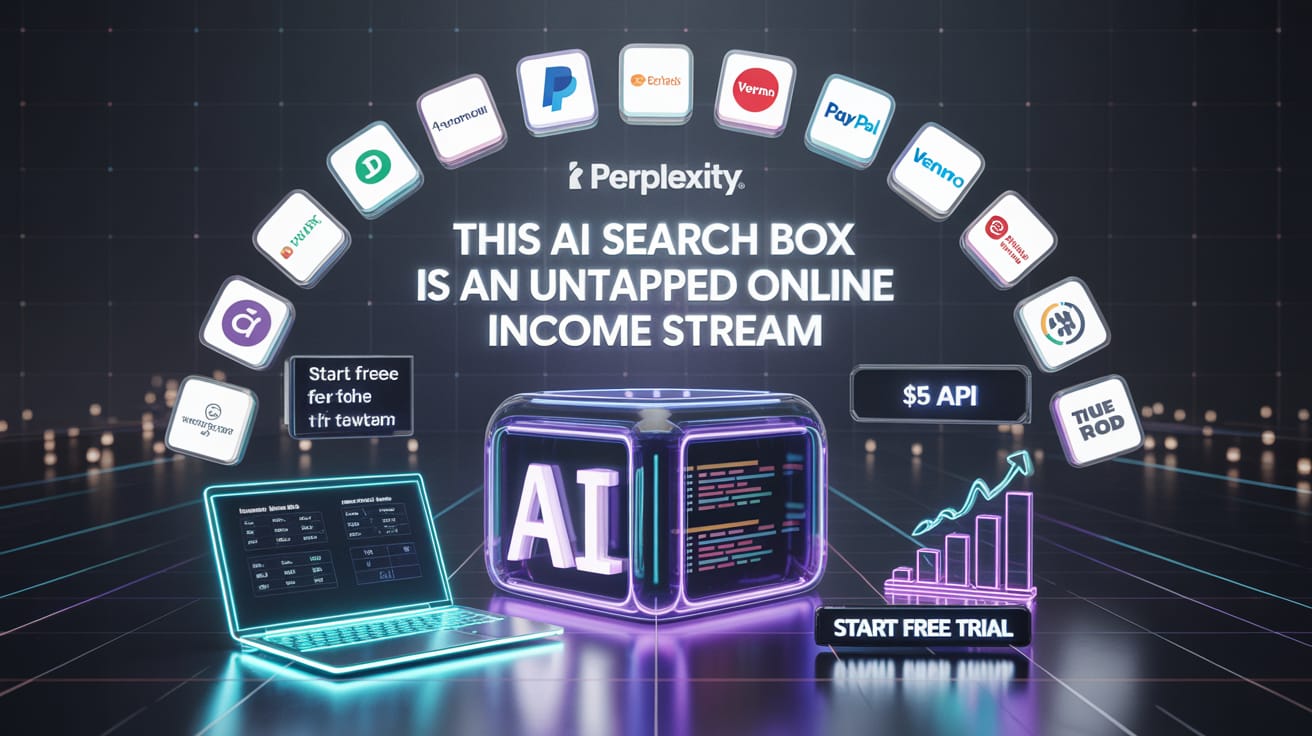
How do you primarily use AI in your content workflow? |
Table of Contents
Most internet users see Perplexity AI as an upgraded search engine - an intelligent "answer box" that helps them escape the clutter of blue links on Google. They see it as a utility, a means for quick lookups. But this perspective misses the vast, highly profitable potential hiding just beneath the surface: Perplexity isn't just a research tool; it's the foundation for an entirely new content business model.
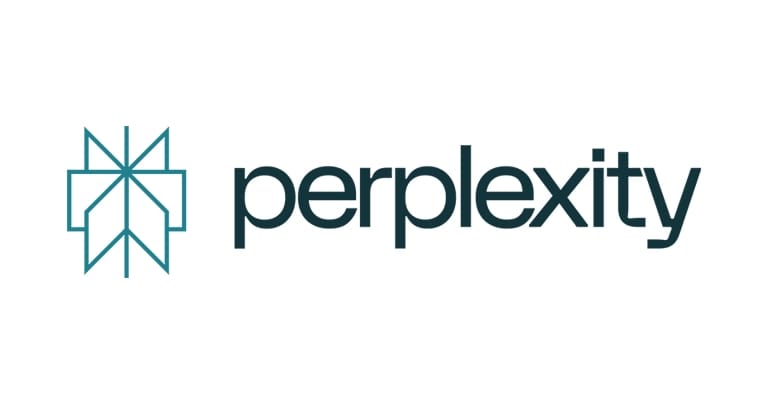
While writers, bloggers, and affiliate marketers are still grappling with the traditional workflow - a chaotic mess of dozens of browser tabs, expensive SEO tools, and the constant fear of outdated information - a new, more efficient approach is quietly reshaping the game. This method leverages Perplexity's real-time data retrieval and source citation capabilities to build monetizable digital assets, from in-depth blogs to high-converting product comparison articles.
This article is not an abstract theory. It is a step-by-step blueprint. You will discover how to transition from manual, time-consuming content creation to an AI-optimized workflow where deep research, market demand validation, and the creation of trustworthy content take hours, not weeks. We will dive deep into how to use Perplexity not just to answer questions, but to identify profitable niches, uncover purchase-intent keywords, and build comparison tables that readers actually trust and click on.
Prepare to change the way you think about creating content and making money online.
What Makes Perplexity A Unique Monetization Tool
To understand Perplexity's earning power, it's crucial to distinguish it from other large language models (LLMs). Tools like ChatGPT from OpenAI or Claude are generative AIs. They excel at producing human-like language, writing creative text, and drafting copy based on the data they were trained on. However, their knowledge is often limited by a cut-off date, making them unreliable for time-sensitive information.

Perplexity operates on a different principle. It is an answer engine or a retrieval and synthesis AI. Its core function is to actively scan the live web, process information from multiple sources, synthesize the findings, and present a coherent answer complete with verifiable citations. It is this fundamental difference that unlocks unique monetization avenues:
Real-Time Data Validation: This is a game-changer for affiliate marketers and product reviewers. Need the latest price of a camera, the features in a new software package, or the terms of a travel insurance policy? Perplexity can retrieve this information directly from pricing pages, press releases, and official websites, ensuring your content is accurate and trustworthy. This accuracy directly translates to higher conversion rates.

Source Citations Enhance Trust (E-E-A-T): Google increasingly prioritizes content that demonstrates Expertise, Experience, Authoritativeness, and Trustworthiness (E-E-A-T). By automatically providing links to its sources, Perplexity allows content creators to quickly verify information and link out to authoritative studies, articles, and data pages. This not only builds trust with readers but also sends positive signals to search engines, potentially leading to higher rankings and better ad revenue.

User Intent Discovery from Live Data: Instead of relying solely on SEO tools for what people are searching for, Perplexity can analyze live discussions from forums like Reddit, Quora, and niche communities. This allows you to discover the actual questions, pain points, and language your target audience is using right now, helping you create hyper-relevant content that addresses unmet needs.

Efficient Research Synthesis: The process of creating a "best of" comparison article traditionally requires opening 20-30 tabs, copy-pasting specs into a spreadsheet, and trying to find common ground. Perplexity automates 90% of this work, synthesizing data from multiple sources into structured tables and lists, freeing you to focus on analysis and storytelling instead of manual data collection.

In short, while other AIs help you write, Perplexity helps you know. And in the content economy, knowing what is true, current, and important is the ultimate competitive advantage.
Learn How to Make AI Work For You!
Transform your AI skills with the AI Fire Academy Premium Plan - FREE for 14 days! Gain instant access to 500+ AI workflows, advanced tutorials, exclusive case studies and unbeatable discounts. No risks, cancel anytime.
Special Offer: Unlock Perplexity Pro For Free For 12 Months
Before we dive into the detailed workflow, there is a special opportunity to significantly upgrade your capabilities. Perplexity AI recently announced a strategic partnership with the popular payment services PayPal and Venmo, offering a deal that's hard to pass up.
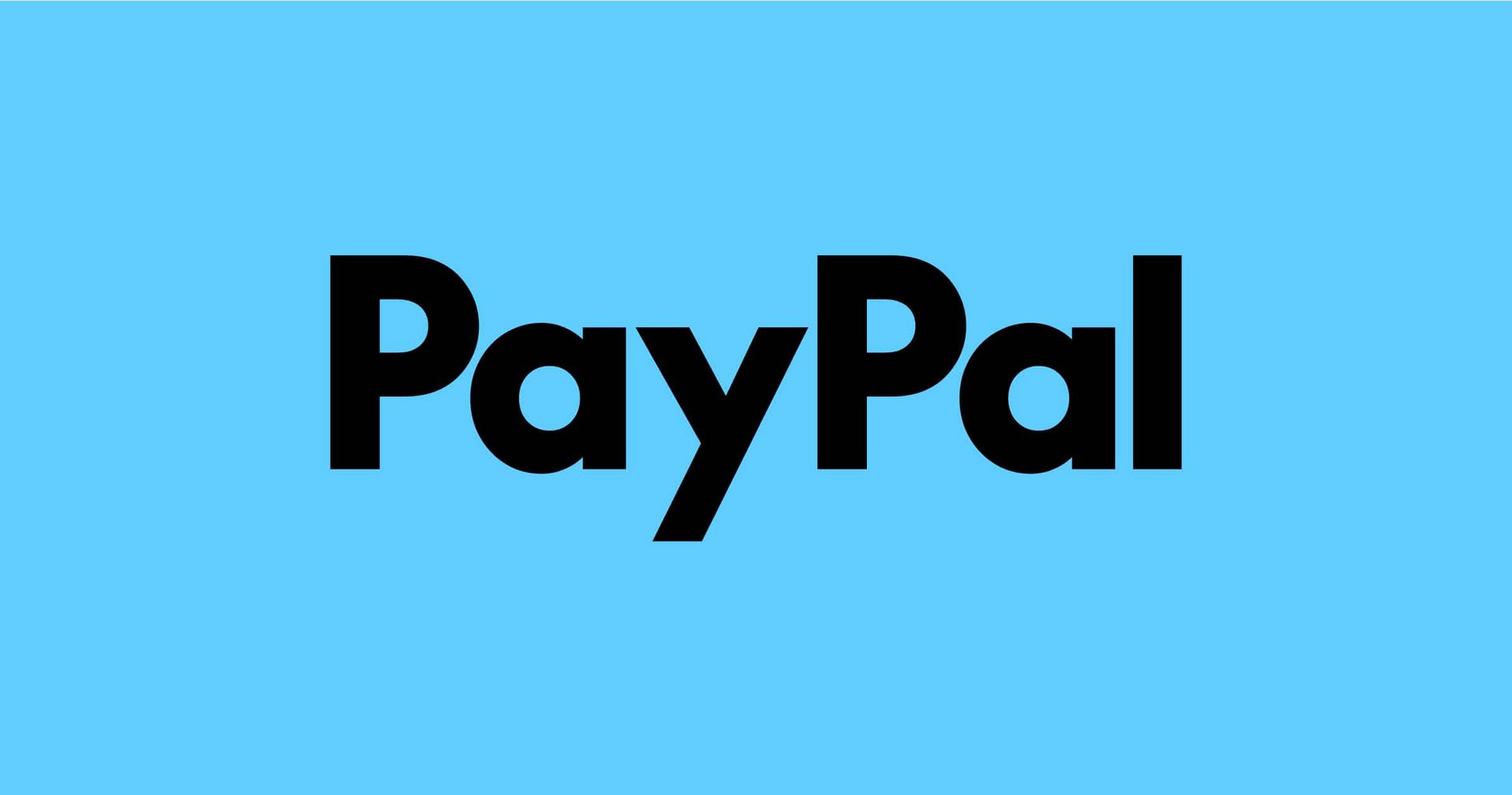
Users can receive 12 months of the Perplexity Pro plan for free, which normally costs $200 per year, simply by linking their PayPal or Venmo account as their payment method. This is a golden opportunity to harness the platform's full potential without any upfront cost.
Why Upgrade To Perplexity Pro?
The Pro plan is not just a minor improvement; it unlocks professional-grade features that are critical for serious content creation:
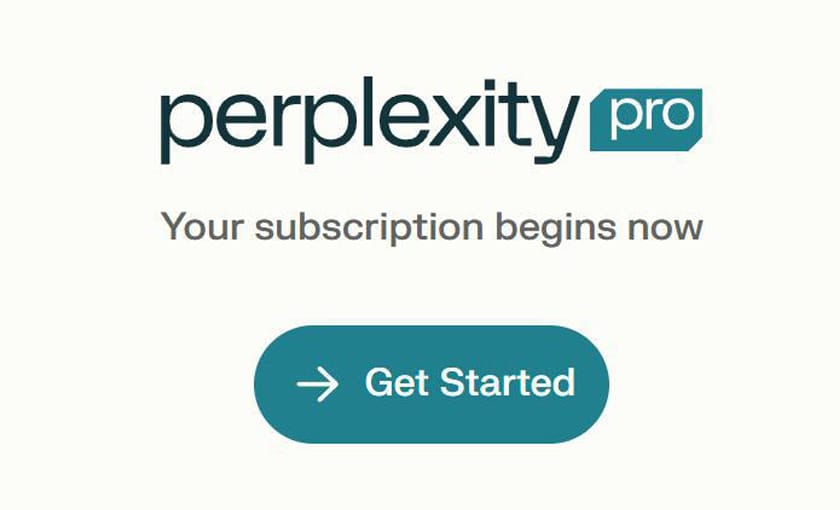
Unlimited Copilot Usage: Copilot is Perplexity's enhanced, interactive query mode that helps clarify questions and perform deeper research. The free plan limits you to just 5 uses every 4 hours; the Pro plan removes this limit entirely.
Unlimited File Uploads: You can upload PDFs, research papers, or text documents and have Perplexity analyze, summarize, or extract data from them. This is invaluable for deep research.
AI Model Selection: Pro users can choose between the most advanced AI models, including OpenAI's GPT-4o and Anthropic's Claude 3 Opus, for higher-quality and more nuanced answers.
API Credits: You receive $5 in API credits monthly, which is useful if you want to integrate Perplexity's power into your own custom applications or workflows.
How to Claim the Offer:
The process is incredibly simple:
Visit the offer page: Go to the official promotion link: https://www.perplexity.ai/join/p/paypal-subscription.

Claim the offer: Click the "Claim 12 months of Perplexity Pro" button.

Log in and Link: You will be prompted to log in to your Perplexity account (or create a new one). Then, follow the instructions to sign in to your PayPal or Venmo account and authorize it as a payment method.

Confirmation: Once linked, your account will be upgraded to Pro instantly. No charge will be made; this is simply a verification method.
Important Terms And Conditions:

Deadline: This offer is valid through December 31, 2025.
Eligibility: The program is only for users who have never subscribed to Perplexity Pro before.
Account Condition: PayPal accounts created before September 1, 2025, will have the offer activated immediately. Accounts created after this date will have a 30-day waiting period.
Maintenance: You must keep PayPal/Venmo as the payment method on your Perplexity account for the full 12-month period to retain Pro access.
Taking advantage of this offer is a smart first step to implementing the strategy outlined in this guide with maximum power.
The Perplexity-To-Profit Blueprint: A Step-By-Step Guide
Now, let's get to the core of the strategy. This workflow is designed to be repeatable and adaptable to almost any niche, from personal finance to gardening tools, from business software to pet care products.
Step 1: Identify Topics With High Purchase Intent
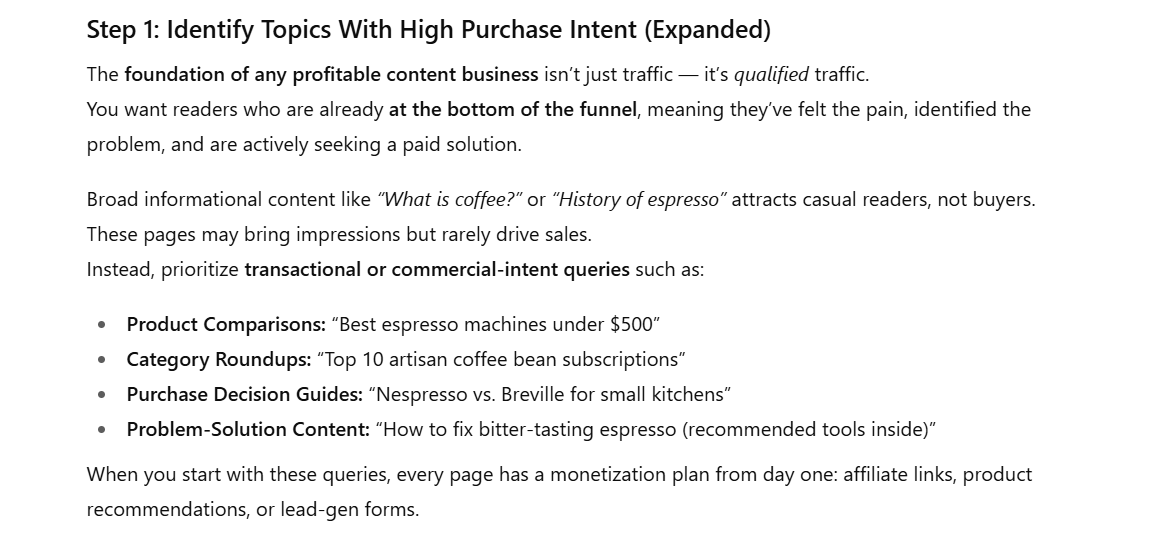
The foundation of any profitable content venture isn't traffic, it's traffic with purpose. You need to target topics where the reader is in the final stages of the buying journey - they have identified a problem and are actively looking for a solution they are willing to pay for.
Avoid broad, informational topics like "What is coffee?". Instead, focus on transactional and commercial topics like "Best espresso machines under $500" or "Artisan coffee bean subscription comparison."
Use Perplexity to power this initial brainstorming process.
Example Prompt for Niche Discovery:
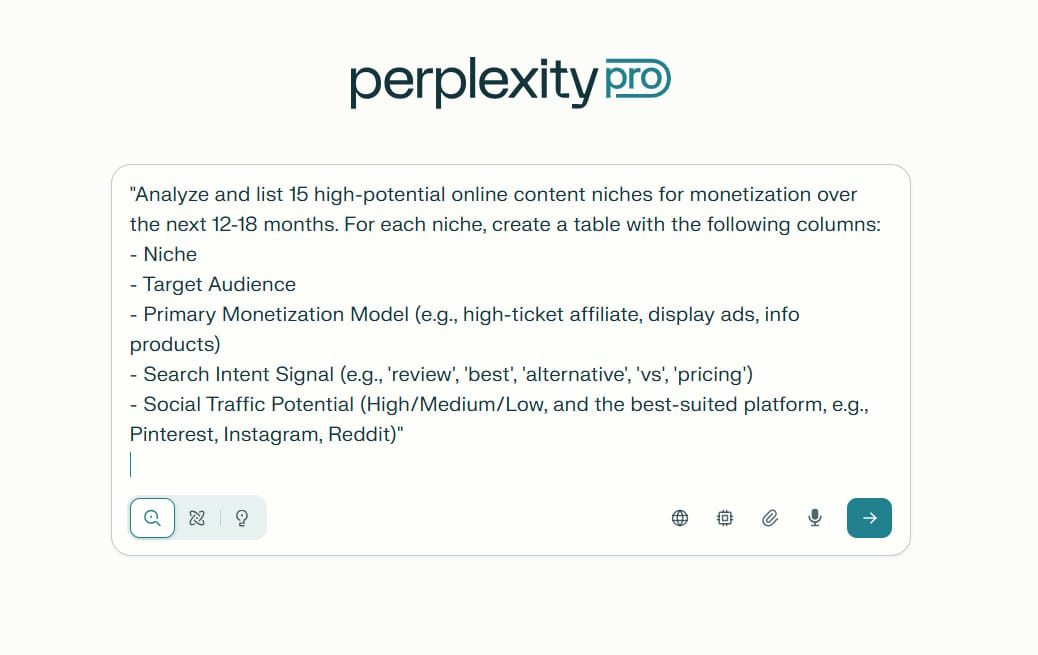
"Analyze and list 15 high-potential online content niches for monetization over the next 12-18 months. For each niche, create a table with the following columns:
- Niche
- Target Audience
- Primary Monetization Model (e.g., high-ticket affiliate, display ads, info products)
- Search Intent Signal (e.g., 'review', 'best', 'alternative', 'vs', 'pricing')
- Social Traffic Potential (High/Medium/Low, and the best-suited platform, e.g., Pinterest, Instagram, Reddit)"
Analyzing the Results:
Top 15 Content Niches Table
Niche | Target Audience | Primary Monetization Model | Search Intent Signal | Social Traffic Potential |
|---|---|---|---|---|
Sustainable Living | Eco-conscious adults | Sponsored posts, affiliate, eBooks | "zero waste tips", "eco product review" | |
Health and Wellness | Wellness seekers, fitness fans | Online courses, affiliate, coaching | "home workout", "diet plan", "best fitness tracker" | High – TikTok, Instagram |
Personal Finance | Millennials, Gen Z | High-ticket affiliate, info products, ads | "best budget app", "investment review", "pricing" | High – TikTok, YouTube |
Technology & AI | Tech enthusiasts | Affiliates, reviews, courses, ads | "AI tools", "vs", "alternative", "review" | High – YouTube, X/Twitter |
Gaming/Esports | Gamers, Gen Z, Millennials | Sponsorships, streaming, affiliate | "game walkthrough", "best gaming headset" | High – Twitch, YouTube, TikTok |
Digital Nomad/Remote Work | Travelers, freelancers | Affiliate travel products, courses | "digital nomad visa", "best coworking space" | High – YouTube, TikTok |
Parenting & Family | Millennials, young parents | Sponsored content, merch, info products | "parenting tips", "best stroller", "review" | High – Instagram, TikTok |
Luxury Lifestyle | Affluent professionals | Brand ambassadorships, affiliates | "luxury travel", "designer review" | Medium – Instagram, YouTube |
Online Learning/Education | Students, professionals | Courses, memberships, YouTube ads | "coding tutorial", "Excel tricks", "how to..." | High – YouTube, Blogs |
Beauty & Skincare | Teens, young adults | Affiliate, own product line, ads | "foundation for oily skin", "product review" | High – TikTok, Instagram |
Pet Products | Pet owners | Dropshipping, affiliate, eCommerce | "best dog food", "pet toy reviews" | High – Instagram, TikTok |
DIY & Home Organization | Homeowners, crafters | Affiliate, eBooks, workshops | "declutter guide", "DIY desk ideas" | Medium – Pinterest, YouTube |
Subscription Box Reviews | Shoppers, collectors | Affiliate, sponsorship, unboxing | "best subscription box", "review", "vs" | Medium – Instagram, YouTube |
Smart Home Automation | Tech homeowners | Affiliate (Amazon, Google), info products | "best smart lock", "setup guide" | Medium – YouTube, Tech Blogs |
Fashion Trends & Advice | Young adults, professionals | Affiliates, own store, sponsored content | "outfit ideas", "fashion hack", "review" | High – Instagram, TikTok |
Perplexity will return a structured list that helps you quickly evaluate opportunities. Look for the intersection of a target audience you understand, a clear monetization model, and strong search intent signals. For example, a niche like "Beginner Smart Home Automation" might show a primary monetization model of affiliate commissions for Amazon, Google, and other brands, with search signals like "best smart lock for apartments," and high potential on YouTube and tech blogs. Pick one that resonates with you to get started.
Step 2: Deep Dive Into Keywords And Intent Clusters
Once you have a niche, you need to map out the specific topics that will attract potential buyers. This is where Perplexity can act as a lean SEO research tool, helping you understand the different angles and questions within your niche.
Example Prompt for Keyword Clustering:
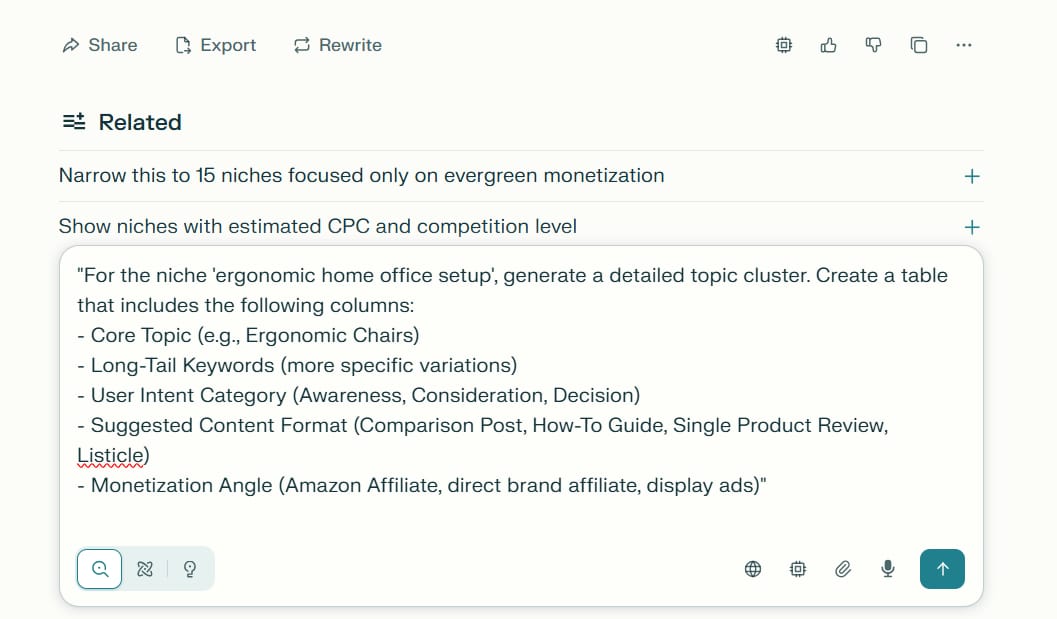
"For the niche 'ergonomic home office setup', generate a detailed topic cluster. Create a table that includes the following columns:
- Core Topic (e.g., Ergonomic Chairs)
- Long-Tail Keywords (more specific variations)
- User Intent Category (Awareness, Consideration, Decision)
- Suggested Content Format (Comparison Post, How-To Guide, Single Product Review, Listicle)
- Monetization Angle (Amazon Affiliate, direct brand affiliate, display ads)"
How to Use This Output:
This output is essentially your content plan for the next few months.
Core Topic | Long-Tail Keywords | User Intent Category | Suggested Content Format | Monetization Angle |
|---|---|---|---|---|
Ergonomic Chairs | "best ergonomic chair for home office", "Herman Miller Aeron vs Steelcase Leap review", "ergonomic chair for back pain" | Decision | Comparison Post, Single Product Review | Amazon Affiliate, Direct brand affiliate |
Standing Desks | "best adjustable standing desk 2025", "standing desk benefits vs regular desk", "affordable standing desks" | Decision/Consideration | Comparison Post, Listicle | Amazon Affiliate, Display ads |
Desk Setup Guides | "how to set up ergonomic home office desk", "proper desk posture setup", "ergonomic desk setup for two monitors" | Awareness/Consideration | How-To Guide, Listicle | Display ads |
Keyboard & Mouse Ergonomics | "best ergonomic keyboard for carpal tunnel", "ergonomic mouse for wrist pain", "keyboard review for programmers" | Decision | Product Review, Comparison Post | Amazon Affiliate, Display ads |
Monitor Placement | "proper ergonomic monitor height", "dual monitor ergonomic setup", "best monitor arms review" | Decision | How-To Guide, Single Product Review | Amazon Affiliate |
Workspace Accessories | "ergonomic footrest for home office", "best lumbar pillow for office chair", "wrist rest review" | Decision | Listicle, Product Review | Amazon Affiliate, Display ads |
Lighting for Productivity | "best home office lighting for eyes", "LED desk lamp ergonomic benefits" | Consideration | How-To Guide, Product Review | Display ads |
Office Organization Tips | "declutter your home office for productivity", "ergonomic storage solutions" | Awareness/Consideration | Listicle, How-To Guide | Display ads |
Posture Tips | "how to maintain correct posture at desk", "prevent back pain working from home" | Awareness | How-To Guide, Listicle | Display ads |
Tech Gadgets | "ergonomic webcam placement", "voice recognition software for ergonomic workflow" | Consideration/Decision | Review, How-To Guide | Amazon Affiliate, Display ads |
Budget Setups | "best cheap ergonomic home office setup", "budget-friendly ergonomic accessories" | Decision/Consideration | Listicle, Comparison Post | Amazon Affiliate, Display ads |
Remote Work Upgrades | "work from home ergonomic essentials", "ergonomic upgrades for remote teams" | Consideration | Listicle, How-To Guide | Display ads, Affiliate |
Brand Reviews | "Autonomous vs Flexispot ergonomic desks", "Steelcase office chair review" | Decision | Comparison Post, Single Product Review | Direct brand affiliate |
Product Alternatives | "Herman Miller Aeron alternative", "budget standing desk alternatives" | Decision | Comparison Post, Listicle | Amazon Affiliate |
Setup Mistakes to Avoid | "common ergonomic setup mistakes", "how to avoid bad desk posture" | Awareness/Consideration | How-To Guide, Listicle | Display ads |
"Decision" keywords (e.g., "Herman Miller Aeron vs Steelcase Leap review") should be your priority, as they have the highest conversion potential. These are your money-making articles.
"Consideration" keywords (e.g., "benefits of an adjustable standing desk") help build trust and capture readers in the middle of their journey.
"Awareness" keywords (e.g., "how to prevent back pain when working from home") attract a broad audience and can be monetized through display ads and by funneling readers to your decision-focused articles.
This table allows you to build a content ecosystem where different articles support each other, guiding the reader from problem to solution.
Step 3: Mine Real User Questions (The Voice Of The Customer)
One of the most powerful ways to build trust and keep readers on your page is to answer their exact questions. FAQ sections are great not only for SEO (especially voice search) but also for showing that you understand your readers' concerns. Perplexity can scour online forums and communities to find these questions.
Example Prompt for FAQ Extraction:
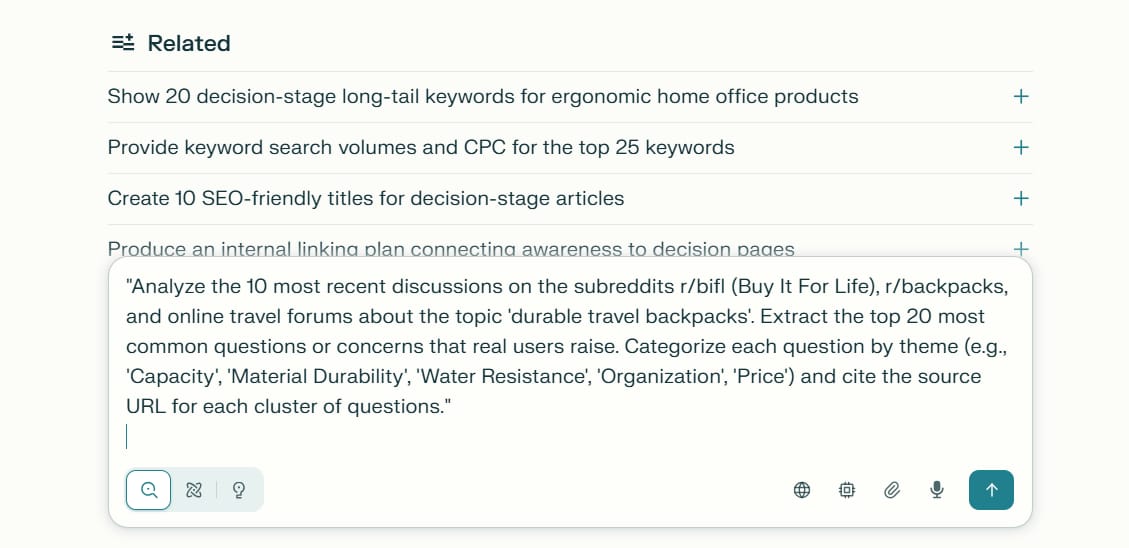
"Analyze the 10 most recent discussions on the subreddits r/bifl (Buy It For Life), r/backpacks, and online travel forums about the topic 'durable travel backpacks'. Extract the top 20 most common questions or concerns that real users raise. Categorize each question by theme (e.g., 'Capacity', 'Material Durability', 'Water Resistance', 'Organization', 'Price') and cite the source URL for each cluster of questions."
Integrating into Your Content:
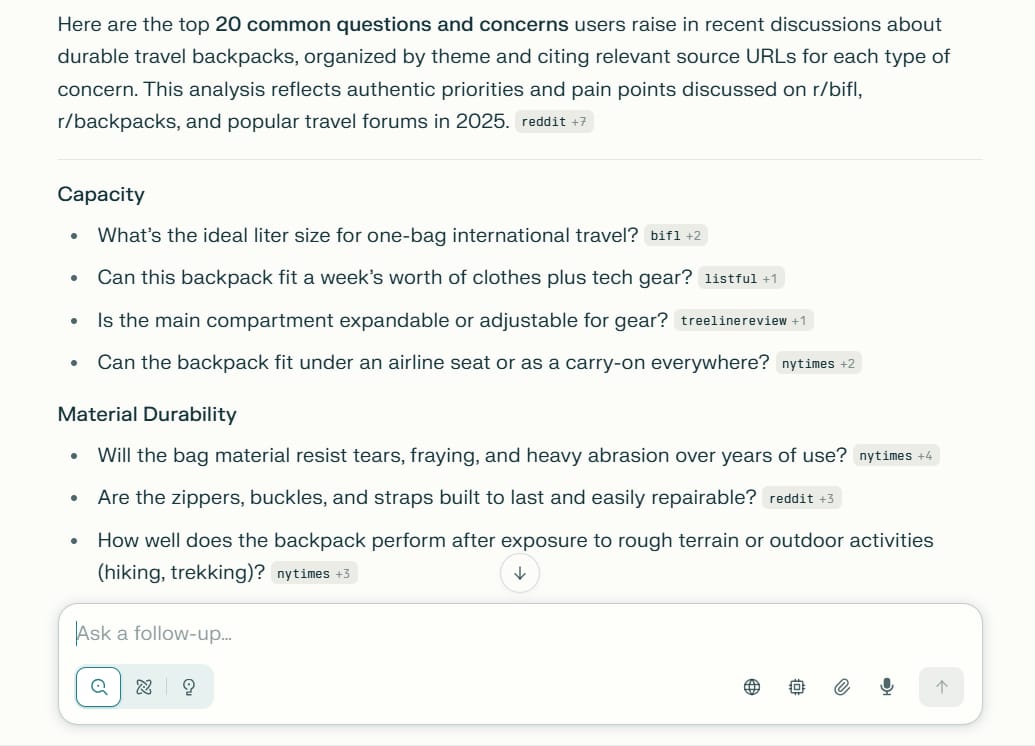
Use these questions to create your subheadings (H2s/H3s). Instead of a generic heading like "Backpack Features," use a real question-based heading like "Do YKK Zippers Really Make a Difference in Durability?". This creates an instant connection with the reader and dramatically increases their time on page, a critical factor for both ad revenue and SEO rankings.
Step 4: Construct High-Conversion Comparison Tables
This is where the real monetization "magic" happens. A well-researched, easy-to-read comparison table is the most powerful tool in an affiliate marketer's arsenal. It condenses complex information into a digestible format, helping readers make a quick decision.
Accuracy is everything. Use Perplexity to gather the data, but commit to manually verifying the most critical data points (like pricing and key features) before publishing.
Example Prompt For Table Generation:
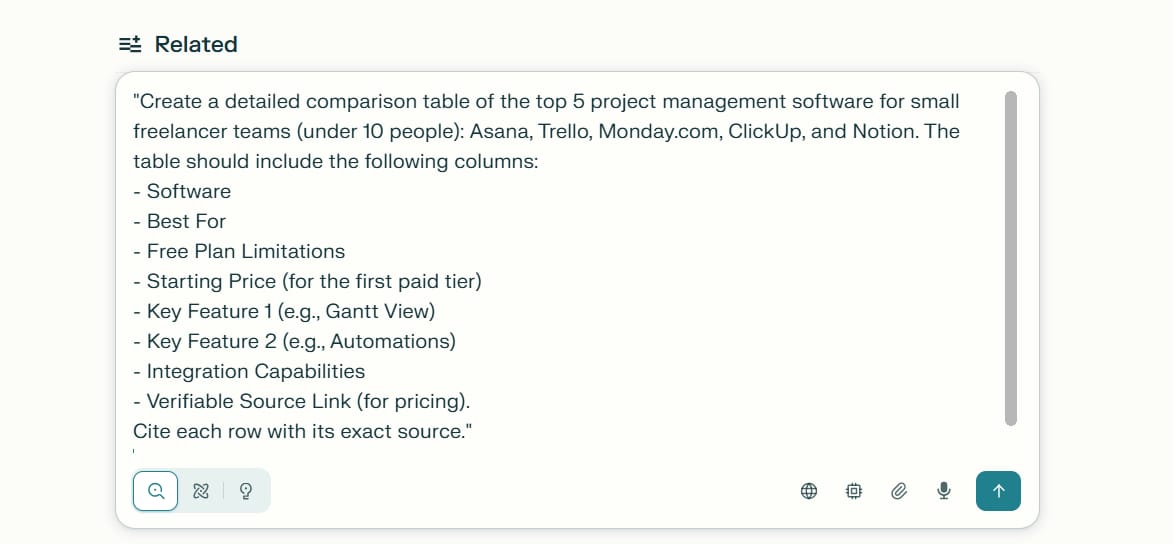
"Create a detailed comparison table of the top 5 project management software for small freelancer teams (under 10 people): Asana, Trello, Monday.com, ClickUp, and Notion. The table should include the following columns:
- Software
- Best For
- Free Plan Limitations
- Starting Price (for the first paid tier)
- Key Feature 1 (e.g., Gantt View)
- Key Feature 2 (e.g., Automations)
- Integration Capabilities
- Verifiable Source Link (for pricing).
Cite each row with its exact source."
Optimizing Your Table:
Here is a detailed comparison table of the top 5 project management software tools for small freelancer teams, including pricing, feature limits, and integration details. To optimize decision-making, entries start with the best overall choice, Trello, and use intuitive icons for feature limits. Affiliate/CTA buttons can be added to each entry as per integration in a real web environment:cirface+4
Software (Affiliate Link) | Best For | Free Plan Limitations | Starting Price (Paid Tier) | Key Feature 1 | Key Feature 2 | Integration Capabilities |
|---|---|---|---|---|---|---|
Visual kanban for simple projects & clients | ![✔️] Up to 10 users, 10 boards, 10MB file attachments; basic Butler automation only | $5/user/month (Standard) | Board (kanban) view | Butler automations | ||
Custom workflows, time tracking | ![✔️] Unlimited users, 100MB storage, limited dashboard/views, automations (100/month) | $7/user/month (Unlimited) | Gantt chart | Automations | Slack, Google Workspace, Zoom, Zapier, GitHub | |
Multi-project management, growing teams | ![✔️] Up to 10 users, no Timeline/Gantt, limited automations (250/month), basic reporting | $10.99/user/month (Starter) | Timeline/Gantt view | Workflow Builder | Slack, Google Workspace, Zapier, Microsoft Teams | |
Visual planning & client portals | ![✔️] Up to 2 seats, 3 boards, basic views, few automations, limited dashboards | $9/user/month (Basic) | Multiple board views | Automations | Slack, Google Workspace, Microsoft Teams, Gmail | |
Docs + simple PM, knowledge management | ![✔️] 10 guests, 5MB uploads, limited history, basic sharing, limited AI | $10/user/month (Plus) | Calendar & Timeline | AI-powered docs | Slack, Google Drive, Zapier, GitHub, Jira |
Once Perplexity generates the draft table, refine it. Order the entries logically (e.g., best overall choice first, followed by alternatives). Use icons (like green checkmarks and red X's) for easy scanning. Most importantly, each product name should be your affiliate link. Place a clear Call-To-Action (CTA) button like "Check Latest Price" or "Start Free Trial" below each entry.
Step 5: The AI-Assisted Drafting Workflow (Perplexity → Claude/ChatGPT)
With all your research, keywords, questions, and comparison tables gathered, it's time to assemble them into a coherent article. This is where generative AIs shine. Think of Perplexity as your lead researcher and Claude or ChatGPT as your staff writer.
Copy all the outputs from the previous steps (the keyword cluster, the FAQ list, the comparison table) and paste them into a single, structured prompt for your AI drafter.
Example Master Drafting Prompt:
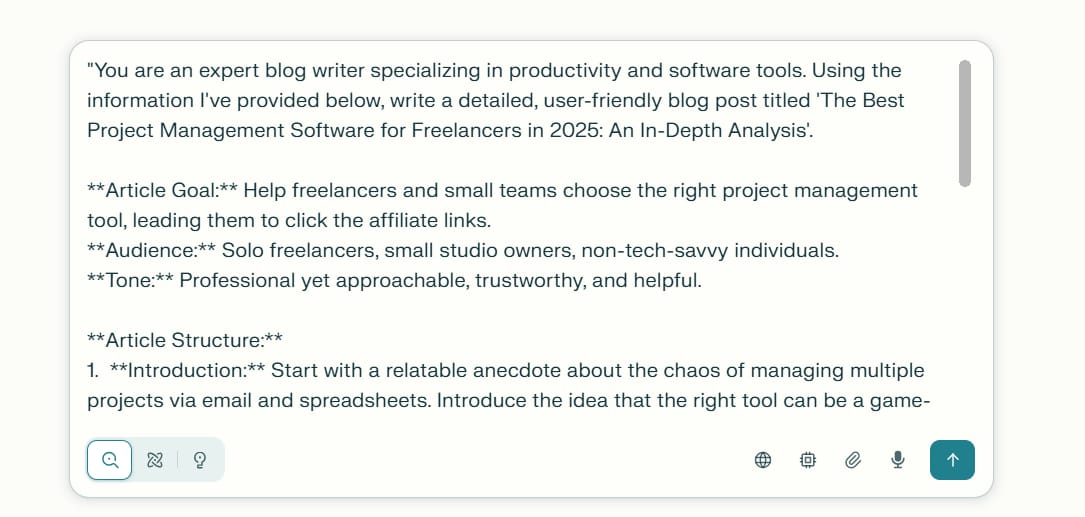
"You are an expert blog writer specializing in productivity and software tools. Using the information I've provided below, write a detailed, user-friendly blog post titled 'The Best Project Management Software for Freelancers in 2025: An In-Depth Analysis'.
**Article Goal:** Help freelancers and small teams choose the right project management tool, leading them to click the affiliate links.
**Audience:** Solo freelancers, small studio owners, non-tech-savvy individuals.
**Tone:** Professional yet approachable, trustworthy, and helpful.
**Article Structure:**
1. **Introduction:** Start with a relatable anecdote about the chaos of managing multiple projects via email and spreadsheets. Introduce the idea that the right tool can be a game-changer.
2. **Why Do Freelancers Need a Project Management Tool?** (A short section explaining the benefits).
3. **Quick Comparison Summary Table:** Insert the COMPARISON TABLE I've provided right at the top.
4. **Detailed Reviews of Each Tool:**
- For each software in the table, write a 300-400 word review section.
- Use the information from the table.
- End each review section with a placeholder link: '[LINK: CHECK PRICE FOR {SOFTWARE NAME}]'.
5. **Frequently Asked Questions (FAQ) Section:** Use the REAL USER QUESTIONS LIST I've provided to create a detailed FAQ section. Answer each question concisely.
6. **Conclusion:** Summarize the top choices for different user types (e.g., 'Best for visual simplicity: Trello', 'Best for ultimate customization: ClickUp') and end with a final call to action.
**Input Data:**
[Paste the keyword table output from Step 2 here]
[Paste the FAQ list output from Step 3 here]
[Paste the comparison table output from Step 4 here]"
After the AI generates the draft, your job is to edit. Add personal insights, adjust the tone, ensure smooth transitions, and double-check every fact for accuracy. The AI does 80% of the heavy lifting; your final 20% adds quality and authenticity.
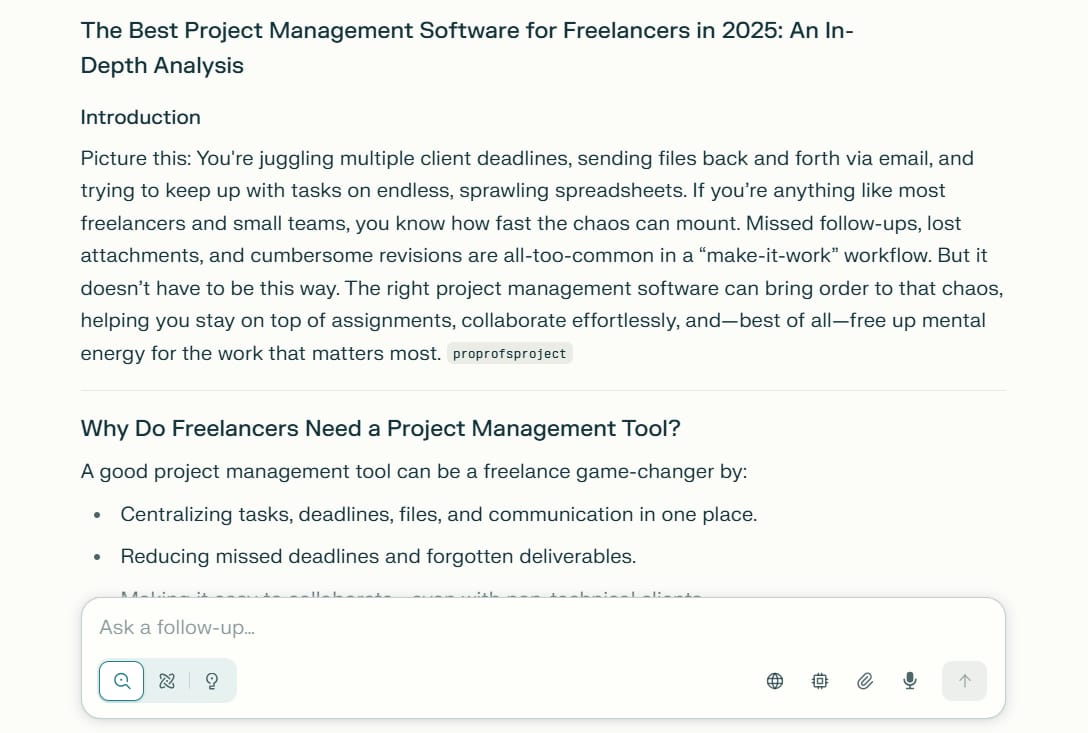
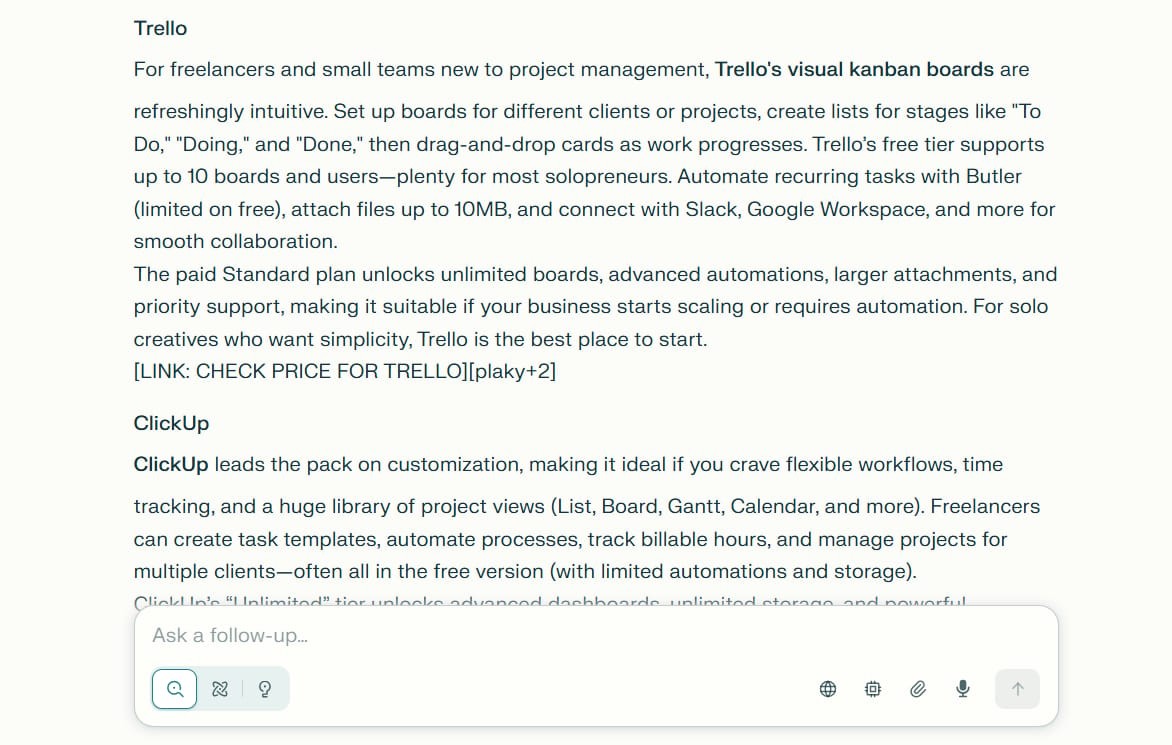
Building The Monetization Stack: Diversifying Your Revenue Streams
Once your article is ready, it's time to integrate monetization. Don't rely on a single source of income.
Display Ads: This is the easiest way to start.
Beginner: Google AdSense is simple to set up but often has a low RPM (revenue per mille, or per thousand impressions).

Intermediate & Advanced: As your traffic grows (typically over 10,000-50,000 sessions/month), apply to premium ad networks like Ezoic, Mediavine, or Raptive. These can increase your ad revenue by 5-10x compared to AdSense.

Affiliate Marketing: This is the primary income source for research-based articles.
Networks: Programs like Amazon Associates are great for physical products. For software and digital services, look for brands on networks like ShareASale or find direct affiliate programs on their websites.

Examples (for a travel article): Booking or Agoda for hotels, SafetyWing for travel insurance, and Wise (formerly TransferWise) for international payments.

Lead Magnets & Email Marketing:

Your most valuable asset is your email list. Offer a free resource in exchange for a reader's email address.
Example: Instead of just writing about Bali honeymoon packages, create a downloadable "Bali Honeymoon Budget Planner Spreadsheet." Use a service like ConvertKit or MailerLite to deliver the file and collect emails.
You can then monetize this list by sending future affiliate offers, new articles, or eventually selling your own info products (e.g., a "Complete Bali Honeymoon Planning Guide" e-book).
Driving Traffic With A Multi-Channel Approach
Great content is useless if no one sees it. While SEO is a long-term strategy, you need initial traffic sources to get the ball rolling.
Pinterest: The Visual Discovery Engine
Pinterest isn't a social network; it's a visual search engine. It is incredibly powerful for niches like travel, home decor, food, fashion, and anything with a strong aesthetic component.

Strategy: Create 5-7 unique Pins for each blog post. Use high-quality vertical images and text overlays to grab attention.
Different Angles: Each Pin should target a different angle of your article. For the Bali honeymoon post, for example:
Cost Angle: "Bali Honeymoon Under $1500? Here's How."
Experience Angle: "Bali Private Pool Villas You Can Actually Afford."
Planning Angle: "5 Mistakes to Avoid When Booking Your Bali Honeymoon."
Question Angle: "Visa, Weather, Safety: Everything You Need to Know About Bali."
Why it Works: Pinterest traffic can come much faster than SEO, and Pins have a very long lifespan, continuing to drive traffic for months or even years.
Other Channels:

Reddit: Find relevant subreddits (e.g., r/travel, r/malefashionadvice) and share your content helpfully when it directly answers someone's question. Don't spam; provide value first.
Facebook Groups: Join niche groups and become an active member. Share your articles when they are relevant to discussions.
Common Pitfalls And Best Practices For Ethical AI Content
Using these powerful tools comes with responsibilities. Avoid these mistakes to build a sustainable business.

Copying Without Verification: The single biggest mistake is blindly trusting the AI's output. Always cross-check critical data (prices, specs, dates). Your credibility is your most valuable asset; don't destroy it through laziness.
Ignoring the Human Element: Articles that are all data and no story are dry. Readers connect with stories, anecdotes, and personal perspective. Inject your own voice. If you don't have personal experience, frame your content as a diligent researcher who has done all the work for the reader.
Focusing on Traffic, Ignoring Intent: A million visitors to an informational post will make less money than a thousand visitors to a review post with clear purchase intent. Always prioritize content that solves a problem and guides a purchasing decision.
Failing to Update Content: Prices change, products are updated, and information becomes obsolete. Set a calendar reminder to review and refresh your cornerstone articles quarterly or bi-annually. This keeps them relevant for both readers and search engines.
Lacking Clear Disclosures: The law (like FTC guidelines in the US) and audience trust both require that you clearly disclose when you are using affiliate links. Place a clear statement at the top of your articles.
Conclusion: The New Competitive Edge
The world of online content creation no longer belongs only to those with the most time or the biggest SEO budget. The competitive edge now belongs to those who can most effectively combine:
Real-Time, Accurate Research (Powered by Perplexity)
Human Storytelling and Trust (Provided by you)
Efficient, Structured Drafting (Aided by Claude or ChatGPT)
Visual Discovery Traffic (Driven by Pinterest and other social platforms)
You don't need to build a content empire overnight. Start small. Pick one niche. Use this workflow to create one well-researched, monetizable article this week. Publish it. Create Pins for it. Then, repeat.
By replacing hours of manual research with targeted Perplexity queries, you free up your time to focus on what truly matters: building a brand, engaging with your audience, and creating content that is genuinely helpful. This isn't just about working smarter; this is the future of profitable content creation.
If you are interested in other topics and how AI is transforming different aspects of our lives or even in making money using AI with more detailed, step-by-step guidance, you can find our other articles here:
Let's Find the Best Ecommerce Platform to Sell Your AI Art for Passive Income
Using AI for Profitable Amazon KDP Children's Books*
*indicates a premium content, if any
How well did this guide cover the topic of "making money with AI"? |
Reply